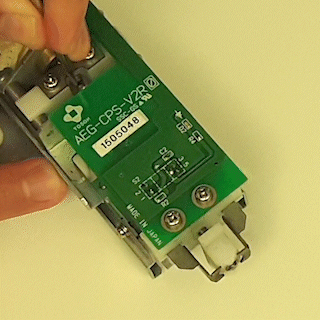As I noted when posting the ware, I actually don’t know what its original function was — it’s just a gizmo I picked out of a junk bin in Akihabara.
Personally, I could not figure out the grabby motion until I actuated the central plunger manually:

So, I was impressed that Ian Mason could infer this was a grabby thing by just looking at it; so I’ll say he’s the winner. Congrats, email me for your prize!
The plunger in the middle is, as far as I can tell, just a passive element on a spring with an optical interrupter on the other side. It probably serves to ensure that both a thing was picked up, and that the thing stays put inside the grabbers. As others had noted in the comment thread, the entire assembly can be moved up and down through a limited range of motion via the motor on the side. The “floating” optical interrupter just next to the side-motor indicates to me that this entire assembly probably was mounted on another axis that moved laterally – possibly at a fairly high speed, since the grabbed object was held in place during transport. A final clue, which was not obvious from the photos, is that there is an outline of a dark ring on the inside surface of the grabbers, but there’s virtually no other wear marks of note.
The logo on the assembly is for the Tosoh corporation, a Japanese company that produces…chemicals, but like many Japanese corporations, is vertically integrated; it would not surprise me if they had an entire in-house automation group devoted to building custom assembly lines with gear that bears their logo.
My guess is that this was actually part of a production or packing line for a Tosoh product: it picked up something small and ring-like (about the diameter of an 18650 battery) from a feeder off to the side of a production line and placed it onto an assembly or into a box. It was in a bin with a number of other similar-sized actuators, no two the same, so I’m guessing a production line was retired, and the various custom heads used to grip parts and pieces from the assembly line found its way to the junk shop.
Well that was a surprise. I’m not sure that I feel like a particularly deserving winner, the basic mechanics were to my mind fairly obvious.
I’ve obviously spent too much time staring at disk driver actuator mechanisms, which on older, slower drives aren’t too dissimilar to this. Modern ones tend to use voice coils and a pivot rather than sliding arms.
Where in Akihbara did you pick this gizmo up?
The signs says “super junk” (スーパージャンク) on the outside in katakana – 1 Chome-3-9 Sotokanda, Chiyoda City, Tokyo 101-0021, Japan.